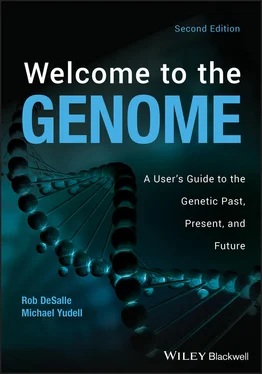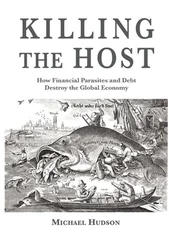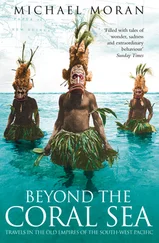The charisma of the genome lies instead in its possibilities, not simply in what a molecule of DNA can do, but in what DNA can do for us—its potential to better the human condition and to alter our environment in ways once only dreamed of. Therein lies the public’s fascination with the genome and with other biotechnologies.

Figure I.2This artist’s conception of a DNA double helix was displayed in the exhibit “The Genomic Revolution.”
Credit: Denis Finnin, American Museum of Natural History
Despite popular and sometimes scientific opinion to the contrary, genes are not the determinative force that many contend or hope they are. Claims of genetic control over intelligence, sexuality, and aggression have come and gone and will come and go again. However, although genes unquestionably contribute to behavioral and medical outcomes, they generally do not govern how we behave or entirely control what diseases we contract or develop. There is a tendency to confuse genetic destiny and genetic potential—a confusion that lies in our changing understanding of gene function. For nearly a century the dominant paradigm in human heredity theory boasted that traits were inherited via single genes (or loci). Scientific support for a one‐gene, one‐trait approach in genetics was, in fact, borne out by many of the genetic discoveries of the twentieth century. It was easy to show, for example, that certain traits are directly inherited through the mechanism of a single gene. Devastating diseases such as sickle‐cell anemia, Huntington disease, and Tay–Sachs disease could all be pinpointed to a single locus. Ultimately, this approach has been fruitful only in the simplest cases of inheritance. The inheritance of these types of diseases is rare, probably accounting for “no more than 5% of known disease.” (8) Yet, this single‐gene, single‐trait approach still holds considerable sway—even more than a decade into the post‐genomic era—among the general public. This despite science’s failure to genetically understand common and stubborn diseases such as cancer, heart disease, and diabetes, all of which claim many lives each year, and all of which have complex etiologies that are both genetic and environmental. If genetics in the twentieth century was about the search for origins of human traits gene by gene, then twenty‐first‐century genomics is about the transition away from single‐gene thinking and toward thinking about organisms as complex biological systems that are always interacting with our environments.
Genomic technologies are opening up new ways of thinking about the mechanisms of our heredity, disease, and evolutionary history on this planet. For instance, the post‐genomic world has altered our view of the microbial world, and scientists are coming to understand how the microbiome impacts our health. In the field of microbial infectious disease, germ theory has dominated the way we look at and treat infectious disorders for over a century. But post‐genomic technology allows us to look at and characterize the communities of microscopic organisms involved in the functioning of our bodies in new ways, thus revolutionizing the germ theory of infectious disease. This new germ theory/microbiome paradigm is, in many ways, a radical change. Where we once thought of interactions with microbes as arms races against specific pathogens (using antibiotics to defeat microorganisms that threatened us), we are beginning to view our health more as a détente between our cells and the cells of communities of microbes.
Another area of paradigm shift in health‐related research in the post‐genome world involves assessing genetic variability between and among human populations. The initial paradigm in using the genome to study genetic disorders was to use a group‐based approach (usually using race) called Genome Wide Association Studies (GWAS) to look for correlation of disease with genetic polymorphism. This race‐based approach has slowly given way to individualized approaches to health and a new hope for personalized medicine. Coincidentally, the sequencing of large numbers of Homo sapiens for projects like the 1000 genomes project have also led to a broader understanding, and in some cases confusions, about the relationships of human population groups to each other and a better understanding of the involvement of genetics in our conception of race.
Genes are not destiny, and such an assertion undermines the astonishing complexity and possibility that are our genes. But if the role of genes in our lives is not this simple, then why read any further? After all, you are reading a “user’s guide” to your genes and may have been expecting us to tout the wonders of our genetic code. We are enchanted by the genome and its potential to change our lives in so many ways, but there is so much more to genes and the genomic revolution than the divine‐like control and global panacea that is often ascribed to them. By reading this book you will learn about the myths and realities of the genome, and in doing so prepare yourself to be an educated participant in the changes to come. We must remember that the sequence of the human genome is only a first step, and that despite the promises ahead, genomics is still in its infancy. It is likely that we cannot even envision some of what is to come, our imaginations lacking the technological and biological prowess to see a future beyond science fiction. Educating ourselves about the genome will no doubt improve our visionary skills and empower us to be participants in these amazing times. Putting the genome to work raises questions and dilemmas for us as individuals, families, nations, and even as a species. We need to make decisions about our health, our food, our stewardship of the natural world, and our responsibilities to the next generation.
Welcome back to the genome.
1 1. Richard Saltus. 2000. “Decoding of Genome Declared,” Boston Globe (June 27, 2000): p.A1.
2 2. Nicholas Wade. 2000. “Reading the Book of Life,” New York Times (June 27, 2000): p.A1.
3 3. Nicolas Wade. 2001. “Long Held Beliefs are Challenged by New Human Genome Analysis,” NYTimes (February 21, 2001): p.A20, https://www.nytimes.com/2001/02/12/us/long‐held‐beliefs‐are‐challenged‐by‐new‐human‐genome‐analysis.html; Natalie Angier. 2001. “Reading the Book of Life: Genome Shows Evolution Has an Eye for Hyperbole,” NYTimes (February 13, 2001): p.F1, https://www.nytimes.com/2001/02/13/science/reading‐the‐book‐of‐life‐genome‐shows‐evolution‐has‐an‐eye‐for‐hyperbole.html; Geoff Dyer, David Firn, and Victoria Griffith, 2003. “Double Helix is Starting to Make its Mark in Medicine,” Financial Times (July 4, 2003): p.20.
4 4. Hallam Stevens. 2015. “Networks’ Representations and Tools in Postgenomics,” in Postgenomics: Perspectives on Biology After the Genome. Sarah S. Richardson and Hallam Stevens, eds. Durham, NC: Duke University Press, p.105.
5 5. Evelyn Fox Keller. 2015. “The Postgenomic Genome,” in Postgenomics: Perspectives on Biology After the Genome. Sarah S. Richardson and Hallam Stevens, eds. Durham, NC: Duke University Press, p.25.
6 6. Leif Bertilsson. 1995. “Geographical/Interracial Differences in Polymorphic Drug Oxidation. Current State of Knowledge of Cytochromes P450 (CYP) 2D6 and 2C19.” Clinical Pharmacokinetics 29: pp.192–209.
7 7. Terence R. Flotte. 2015. “Therapeutic Germ Line Alteration: Has CRISPR/Cas9 Technology Forced the Question? Human Gene Therapy 26: pp.245–246.
8 8. Kenneth Olden and Samuel Wilson. 2000. “Environmental Health and Genomics: Visions and Implications.” Nature Reviews Genetics 1: pp.149–153.
Читать дальше













